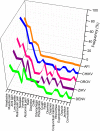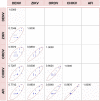Emerging and reemerging arboviruses: A new threat in Eastern Peru
- PMID: 29136650
- PMCID: PMC5685628
- DOI: 10.1371/journal.pone.0187897
Emerging and reemerging arboviruses: A new threat in Eastern Peru
Abstract
Background: Arboviral diseases are one of the most common causes of acute febrile illness (AFI) and a significant health problem in South America. In Peru, laboratory etiologic identification of these infections occurs in less than 50% of cases, leading to underdiagnoses of important emerging arboviruses.
Aim: To assess the prevalence of the Dengue (DENV), Oropouche (OROV), Chikungunya (CHIKV), Mayaro (MAYV) and Zika (ZIKV) viruses in patients with acute febrile illness from Puerto Maldonado (Peru).
Methodology: Serum samples were obtained from patients with AFI during January 2016 to March 2016. A total of 139 specimens were analyzed for the presence of DENV, OROV, CHIKV, MAYV, and ZIKV using polymerase chain reaction (PCR).
Results: CHIKV in 9.4% and OROV in 8.6% were the most prevalent arboviruses, followed by DENV and ZIKV, with a prevalence of 6.5% and 5%, respectively. Among all patients, the most common symptoms accompanying fever were headaches 79.9%, muscle pain 65.5% and joint pain 63.3%.
Conclusions: During this short 3-month period, 4 arboviruses were detected by PCR, CHIKV and OROV being the most common arboviruses in Puerto Maldonado (Peru). Thus, it is crucial to include OROV detection in the national health surveillance. Furthermore, the etiologic clinical diagnosis of arboviral infections is not possible due to the low specificity of symptoms; therefore an increase of cases confirmed by molecular diagnostic methods will enhance arboviral surveillance in Peru.
Conflict of interest statement
Figures



References
-
- Forshey BM, Guevara C, Laguna-Torres VA, Cespedes M, Vargas J, Gianella A, et al. Arboviral etiologies of acute febrile illnesses in Western South America, 2000–2007. PLoS Negl Trop Dis. 2010;4(8): e787 doi: 10.1371/journal.pntd.0000787 - DOI - PMC - PubMed
-
- Mourão MP, Bastos Mde S, Figueiredo RM, Gimaque JB, Alves Vdo C, Saraiva Md, et al. Arboviral diseases in the Western Brazilian Amazon: a perspective and analysis from a tertiary health & research center in Manaus, State of Amazonas. Rev Soc Bras Med Trop. 2015;48 Suppl 1:20–6. - PubMed
-
- Lorenzi OD, Gregory CJ, Santiago LM Acosta H, Galarza IE, Saint Luke's Acute Febrile Illness Investigation Team, et al. Acute febrile illness surveillance in a tertiary hospital emergency department: comparison of influenza and dengue virus infections. Am J Trop Med Hyg 2013; 88:472–480. doi: 10.4269/ajtmh.12-0373 - DOI - PMC - PubMed
-
- Iroh Tam PY, Obaro SK, Storch G. Challenges in the Etiology and Diagnosis of Acute Febrile Illness in Children in Low- and Middle-Income Countries. J Pediatric Infect Dis Soc. 2016;5(2):190–205. doi: 10.1093/jpids/piw016 - DOI - PMC - PubMed
MeSH terms
LinkOut - more resources
Full Text Sources
Other Literature Sources
Molecular Biology Databases

